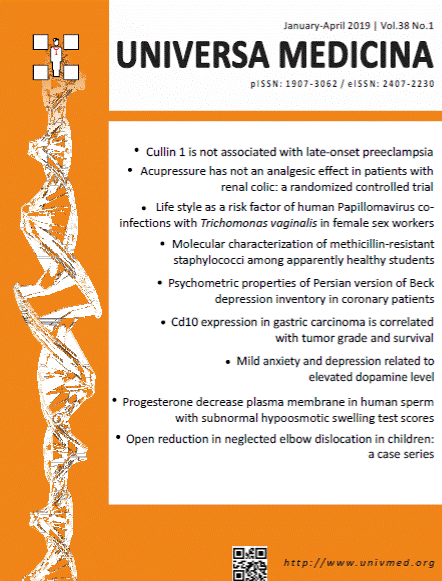Psychometric properties of Persian version of Beck depression inventory in coronary patients
Main Article Content
Abstract
Obtaining psychometric properties regarding specific populations increases diagnostic accuracy and reduces economic health burdens. Beck depression inventory-second version (BDI-II) is useful for the screening and assessment of depression in clinical and research settings. The aim of the present study was to investigate the psychometric properties of the Persian (Farsi) version of BDI-II in patients with coronary heart disease (CHD).
Methods
A cross-sectional study was conducted on 284 patients with CHD admitted to Imam Ali Hospital in Kermanshah. They were first given a structured clinical interview (SCID-I) and then were asked to complete the Beck depression inventory-II (BDI-II), patient health questionnaire 9 (PHQ-9) and generalized anxiety disorder 7 (GAD-7). Data were analyzed by descriptive statistics, Cronbach’s á, Spearman’s correlation coefficient, exploratory factor analysis and receiver operating characteristic curve (ROC).
Results
The internal consistency measured using Cronbach’s alpha was 0.90. The obtained correlation of BDI-II with PHQ-9 and GAD-7 was 0.74 and 0.65, respectively (p< 0.001). Factor analysis of the inventory revealed 5 factors, namely cognitive, somatic , impaired performance , negative attitude to self and ,and self punishment respectively. The cut-off point for CHD patients was 11 with sensitivity of 0.78 and specificity of 0.81 according to the Youden index and 10 with sensitivity of 0.80 and specificity of 0.77 according to the two-stage approach. The area under the curve was 0.86 (95% Confidence Interval 0.82-0.90).
Conclusion
The Persian version of the BDI-II possesses the acceptable psychometric properties that can be used to screen depression in CHD patients.
Article Details
The journal allows the authors to hold the copyright without restrictions and allow the authors to retain publishing rights without restrictions.
References
Kang HJ, Kim SY, Bae KY, et al. Comorbidity of depression with physical disorders: research and clinical implications. Chonnam Med J 2015;51:8-18. doi: 10.4068/cmj.2015.51.1.8.
Smith HR. Depression in cancer patients: pathogenesis, implications and treatment. Oncol Lett 2015;9:1509-14. doi: 10.3892/ol.2015.2944.
Hare DL, Toukhsati SR, Johansson P, et al. Depression and cardiovascular disease: a clinical review. Eur Heart J 2014;35:1365-72. doi: 10.1093/eurheartj/eht462.
Tully PJ, Baumeister H. Collaborative care for the treatment of comorbid depression and coronary heart disease: a systematic review and meta-analysis protocol. Systematic Reviews 2014;3:127. doi.org/10.1186/2046-4053-3-127.
Ren Y, Yang H, Browning C, Thomas S, et al. Prevalence of depression in coronary heart disease in China: a systematic review and meta-analysis. Chin Med J 2014;127:2991-8. doi: 10.3760/cma.j.issn.0366-6999.20140036
Ghaemmohamadi MS, Behzadifar M, Ghashghaee A, et al. Prevalence of depression in cardiovascular patients in Iran: a systematic review and meta-analysis from 2000 to 2017. J Affect Disord 2018;227:149-55. doi: 10.1016/j.jad.2017.10.026.
Carney RM, Freedland KE. Depression and coronary heart disease. Nat Rev Cardiol 2017;14:145. doi: 10.1038/nrcardio.2016.181.
Lichtman JH, Froelicher ES, Blumenthal JA, et al. Depression as a risk factor for poor prognosis among patients with acute coronary syndrome: systematic review and recommendations: a scientific statement from the American Heart Association. Circulation 2014;129:1350-69.-69. doi: 10.1161/CIR.0000000000000019.
Baird D, Jackson AC, Higgins RO, et al. Screening, assessment and treatment for depression in patients with chronic heart failure. Br J Card Nurs 2018;13:386-93. doi: 10.12968/bjca.2018.13.8.386.
Ceccarini M, Manzoni GM, Castelnuovo G. Assessing depression in cardiac patients: what measures should be considered? Depres Res Treat 2014; Article ID 148256, 17 pages. DOI: http://dx.doi.org/10.1155/2014/148256(3):148256.
Ginting H, Näring G, van der Veld WM, et al. Validating the Beck depression inventory-II in Indonesia’s general population and coronary heart disease patients. Int J Clin Health Psychol 2013;13:235-42. doi:10.1016/S1697-2600(13)70028-0.
Moullec G, Plourde A, Lavoie KL, et al. Beck depression inventory II: determination and comparison of its diagnostic accuracy in cardiac outpatients. Eur J Prev Cardiol 2015;22:665-72. doi: 10.1177/2047487314527851.
Abubakar A, Kalu RB, Katana K, et al. Adaptation and latent structure of the Swahili version of Beck depression inventory-II in a low literacy population in the context of HIV. PloS One 2016;11:e0151030. doi: 10.1371/journal.pone. 0151030.
Tajfard M, Ghayour-Mobarhan M, Rahimi HR, et al. Anxiety, depression and coronary artery disease among patients undergoing angiography in Ghaem hospital, Mashhad, Iran. Health 2014; 6:1108. doi: 10.4236/health.2014.611137.
Abbasi SH, Kassaian SE, Sadeghian S, et al. Factors associated with depressive symptoms in young adults with coronary artery disease: Tehran heart center’s premature coronary atherosclerosis cohort (THC-PAC) study. Iran J Psychiatry 2016; 11:214-23.
Najafipour H, Banivaheb G, Sabahi A, et al. Prevalence of anxiety and depression symptoms and their relationship with other coronary artery disease risk factors: a population-based study on 5900 residents in Southeast Iran. Asian J Psychiatr 2016;20:55-60. doi: 10.1016/j.ajp.2016.01. 004.
Wang YP, Gorenstein C. Psychometric properties of the Beck depression inventory-II: a comprehensive review. Braz J Psychiatry 2013;35:416-31. doi: 10.1590/1516-4446-2012-1048.
First MB, Williams J, Karg RS, et al. User’s guide to structured clinical interview for DSM-5 disorders (SCID-5-CV) clinical version: Arlington, VA: American Psychiatric Publishing; 2015.
Beck AT, Steer RA, Brown GK. Manual for the Beck depression inventory-II. San Antonio, TX: Psychological Corporation;1996.
Kroenke K, Spitzer RL, Williams JB. The PHQ 9: validity of a brief depression severity measure. J Gen Intern Med 2001 ;16:606-13. doi:10.1046/j1525-14972001016009606x
Spitzer RL, Kroenke K, Williams JBW, et al. A brief measure for assessing generalized anxiety disorder: The GAD-7. Arch Intern Med 2006;166:1092-7. doi:10.1001/archinte.166.10.1092
Lowe B, Spitzer RL, Grafe K, et al. Comparative validity of three screening questionnaires for DSM-IV depressive disorders and physicians’ diagnoses. J Affect Disord 2004;78:131-40. 6723
Hinton PR. Statistics explained. 3rd ed. UK: Routledge; 2014.
García-Batista ZE, Guerra-Peña K, Cano-Vindel A, et al. Validity and reliability of the Beck depression inventory (BDI-II) in general and hospital population of Dominican Republic. PloS One 2018;13:e0199750. doi: 10.1371/journal.pone. 0199750.
Safari S, Baratloo A, Elfil M, et al. Evidence based emergency medicine; Part 5 receiver operating curve and area under the curve. Emergency 2016;4:111-3.
Bunevicius A, Staniute M, Brozaitiene J, et al. Diagnostic accuracy of self-rating scales for screening of depression in coronary artery disease patients. J Psychosom Res 2012;72:22-5. doi: 10.1016/j.jpsychores.2011.10.006.


